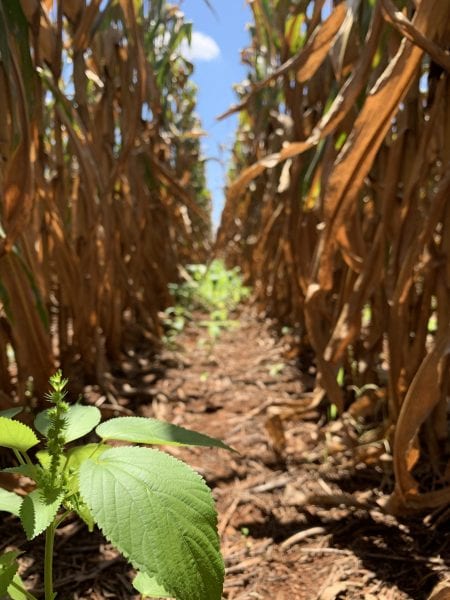Crop Production

As farmers enter harvest season, let’s remember that the work isn’t done just because the crop is out of the field. Planning efforts for next year are already underway and proactive weed control strategies should remain a top priority.
What to Look For
We still have a little over two months before the first frost so there is ample time for weed growth and maturity. In many cases, pigweeds like Palmer amaranth (Amaranthus palmeri) and waterhemp (A. tuberculatus) are most concerning, especially if populations are herbicide resistant. Other problematic species are hophornbeam copperleaf (Acalypha ostryifolia), prickly sida (Sida spinosa), horseweed (Conyza canadensis), and tropical spiderwort or Benghal dayflower (Commelina benghalensis). If these weeds were present during harvest, they may have been cut or damaged, but you can bet they will attempt to flower and produce seed with the remaining warm weather. Amaranth species require sunlight for seed germination. Now that the crop canopy has been removed, be on the lookout for new emergence.
Weed Management Options

Hophornbeam copperleaf is a prolific seed producer, making post-harvest weed control essential to reduce populations.
Tillage is an effective method of post-harvest weed control. However, this practice is discouraged in most cases due to the opportunity for new weed seed emergence upon soil disturbance. Cutting or mowing standing stalks may also aid in weed control because this creates a mulch layer with crop residue that will help impede weed growth and maintain slightly cooler soil surface temperatures. Flail mowers usually do a great job of chopping remaining stalks. Do not solely rely on combine-induced damage as an adequate weed control strategy, especially in high plant populations. Over 80 percent of Amaranth seed production following harvest can be attributed to those plants which recovered from damage induced by mechanical harvest equipment.
Research has shown that postemergence applications of paraquat have been effective at desiccating actively growing weeds during post-harvest. Obviously, plants that were damaged during harvest have a growth advantage compared to new seedlings, but this application will effectively delay weed maturity. Adding a photosystem II-inhibiting (Group 5) or protoporphyrinogen oxidase-inhibiting (Group 14) herbicide like metribuzin, flumioxazin, or saflufenacil will help control regrowth and inhibit new emergence. Adequate regrowth of weeds is necessary for POST herbicides to work effectively.
Keep in mind that weeds like Palmer amaranth are extremely competitive and capable of producing 400,000 t0 1,000,000 seed per female plant. By starting clean and ending clean, farmers can expect to significantly reduce weed seed production. By taking a proactive approach to post-harvest weed control, it’s easy to see the value with respect to resistance management and maximizing profits. Remember to always refer to product labels when applying herbicides and consider following crop rotations, as plant back restrictions may be necessary.
Trade and brand names used are given for information purposes only. No guarantee, endorsement, or discrimination among comparable products is intended or implied by the Alabama Cooperative Extension System.

